It的基本用法
- 格式:ppt
- 大小:1.32 MB
- 文档页数:43
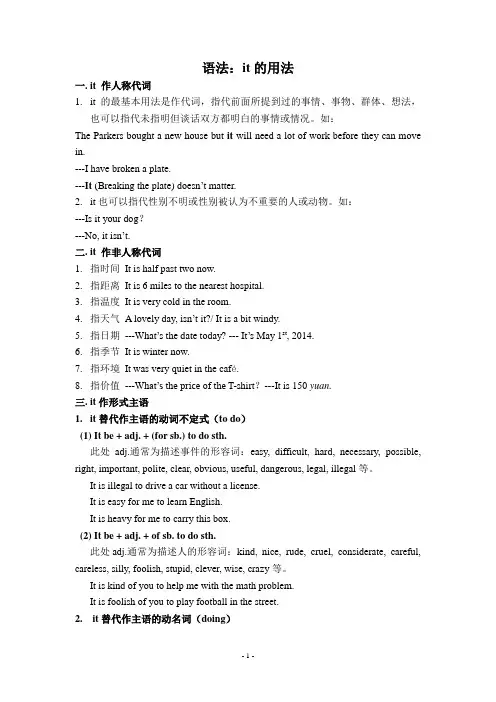
语法:it的用法一.it 作人称代词1.it的最基本用法是作代词,指代前面所提到过的事情、事物、群体、想法,也可以指代未指明但谈话双方都明白的事情或情况。
如:The Parkers bought a new house but it will need a lot of work before they can move in.---I have broken a plate.---It (Breaking the plate) doesn’t matter.2.it也可以指代性别不明或性别被认为不重要的人或动物。
如:---Is it your dog?---No, it isn’t.二.it 作非人称代词1.指时间It is half past two now.2.指距离It is 6 miles to the nearest hospital.3.指温度It is very cold in the room.4.指天气A lovely day, isn’t it?/ It is a bit windy.5.指日期---What’s the date today? --- It’s May 1st, 2014.6.指季节It is winter now.7.指环境It was very quiet in the café.8.指价值---What’s the price of the T-shirt?---It is 150 yuan.三.it作形式主语1.it替代作主语的动词不定式(to do)(1) It be + adj. + (for sb.) to do sth.此处adj.通常为描述事件的形容词:easy, difficult, hard, necessary, possible, right, important, polite, clear, obvious, useful, dangerous, legal, illegal等。
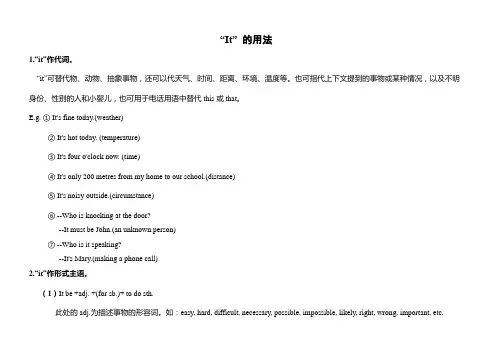
“It” 的用法1.“it”作代词。
“it”可替代物、动物、抽象事物,还可以代天气、时间、距离、环境、温度等。
也可指代上下文提到的事物或某种情况,以及不明身份、性别的人和小婴儿,也可用于电话用语中替代this或that。
E.g. ① It's fine today.(weather)② It's hot today. (temperature)③ It's four o'clock now. (time)④ It's only 200 metres from my home to our school.(distance)⑤ It's noisy outside.(circumstance)⑥ --Who is knocking at the door?--It must be John.(an unknown person)⑦ --Who is it speaking?--It's Mary.(making a phone call)2.“it”作形式主语。
(1)It be +adj. +(for sb.)+ to do sth.此处的adj.为描述事物的形容词。
如:easy, hard, difficult, necessary, possible, impossible, likely, right, wrong, important, etc.E.g. ① It's easy for us to climb the hill.② It's difficult for me to work out the maths problem.(2) It be +adj.+(of sb.)+to do sth.此处的adj.为描述人的形容词。
如:kind, nice, rude, cruel, careful, careless, silly, foolish, stupid, wise, crazy, etc.E.g. ① It's kind of you to help me with this problem.② It's foolish of you to believe in such a person.③ It's wise of you to choose to study abroad.(3). It be + adj.+ doing sth.It's no good/use doing sth.It's (well) worth doing.E.g. ① It's no good arguing with him.② It's no use crying over spilt milk.③ It's no good drinking too much wine.(4) It be +adj./n. +Clause.It's a pity that…It's a fact that…(It's) no wonder that…It's obvious that…It's certain that…It's strange/important/necessary that…(要用虚拟语气)(用should+动词原形)It worries/surprises sb. that…It seems/appears that…It turned out that…It (suddenly) occurred to sb. that…It strikes/struck sb. that…It's said/reported/believed… that…It doesn't matter whether…It makes no di fference whether…(5)其它句型。
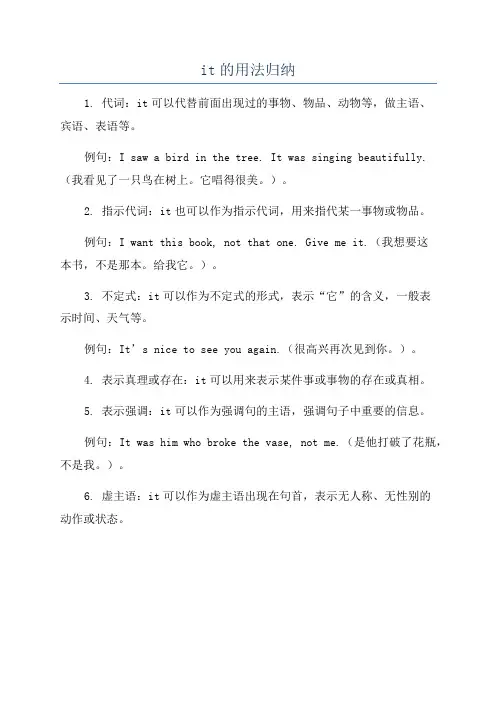
it的用法归纳
1. 代词:it可以代替前面出现过的事物、物品、动物等,做主语、
宾语、表语等。
例句:I saw a bird in the tree. It was singing beautifully. (我看见了一只鸟在树上。
它唱得很美。
)。
2. 指示代词:it也可以作为指示代词,用来指代某一事物或物品。
例句:I want this book, not that one. Give me it.(我想要这
本书,不是那本。
给我它。
)。
3. 不定式:it可以作为不定式的形式,表示“它”的含义,一般表
示时间、天气等。
例句:It’s nice to see you again.(很高兴再次见到你。
)。
4. 表示真理或存在:it可以用来表示某件事或事物的存在或真相。
5. 表示强调:it可以作为强调句的主语,强调句子中重要的信息。
例句:It was him who broke the vase, not me.(是他打破了花瓶,不是我。
)。
6. 虚主语:it可以作为虚主语出现在句首,表示无人称、无性别的
动作或状态。
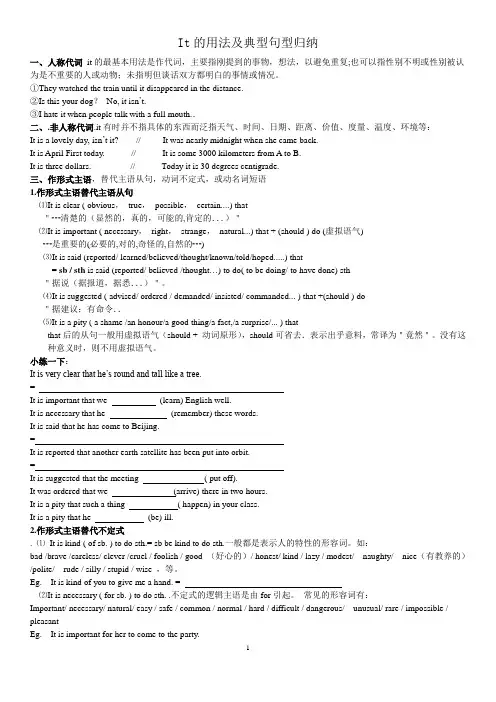
It的用法及典型句型归纳一、人称代词it的最基本用法是作代词,主要指刚提到的事物,想法,以避免重复;也可以指性别不明或性别被认为是不重要的人或动物;未指明但谈话双方都明白的事情或情况。
①They watched the train until it disappeared in the distance.②Is this your dog?No, it isn’t.③I hate it when people talk with a full mouth..二、.非人称代词.it有时并不指具体的东西而泛指天气、时间、日期、距离、价值、度量、温度、环境等:It is a lovely day, isn’t it? // It was nearly midnight when she came back.It is April First today. // It is some 3000 kilometers from A to B.It is three dollars. // Today it is 30 degrees centigrade.三、作形式主语,替代主语从句,动词不定式,或动名词短语1.作形式主语替代主语从句⑴It is clear ( obvious,true,possible,certain....) that"┅清楚的(显然的,真的,可能的,肯定的...)"⑵It is important ( necessary,right,strange,natural...) that + (should ) do (虚拟语气)┅是重要的(必要的,对的,奇怪的,自然的┅)⑶It is said (reported/ learned/believed/thought/known/told/hoped.....) that= sb / sth is said (reported/ believed /thought…) to do( to be doing/ to have done) sth"据说(据报道,据悉...)"。
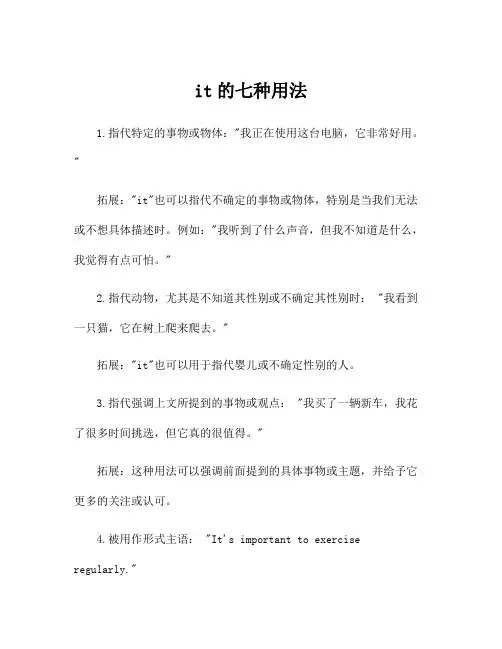
it的七种用法1.指代特定的事物或物体:"我正在使用这台电脑,它非常好用。
"拓展:"it"也可以指代不确定的事物或物体,特别是当我们无法或不想具体描述时。
例如:"我听到了什么声音,但我不知道是什么,我觉得有点可怕。
"2.指代动物,尤其是不知道其性别或不确定其性别时: "我看到一只猫,它在树上爬来爬去。
"拓展:"it"也可以用于指代婴儿或不确定性别的人。
3.指代强调上文所提到的事物或观点: "我买了一辆新车,我花了很多时间挑选,但它真的很值得。
"拓展:这种用法可以强调前面提到的具体事物或主题,并给予它更多的关注或认可。
4.被用作形式主语: "It's important to exercise regularly."拓展:在某些句子中,"it"可以用作形式主语,代表主语部分的内容,尤其是当真正的主语是以后出现时。
5.引导强调句: "It was John who broke the vase."拓展:在强调句中,"it"被用作形式主语,而真正的主语将被放置在句子的后部,以便强调。
6.用于指示时间、天气和环境条件: "It's raining outside."拓展:"it"在描述天气、时间或条件时,常用于英语中,例如:"It's getting late." "It's hot today."7.在某些习语中,表示状态或情感: "I'm over it." (我已经度过了这个困境)拓展:在某些习语或俚语中,"it"用于表示情感、状态或体验,并在一定程度上代表所描述的特定情况。
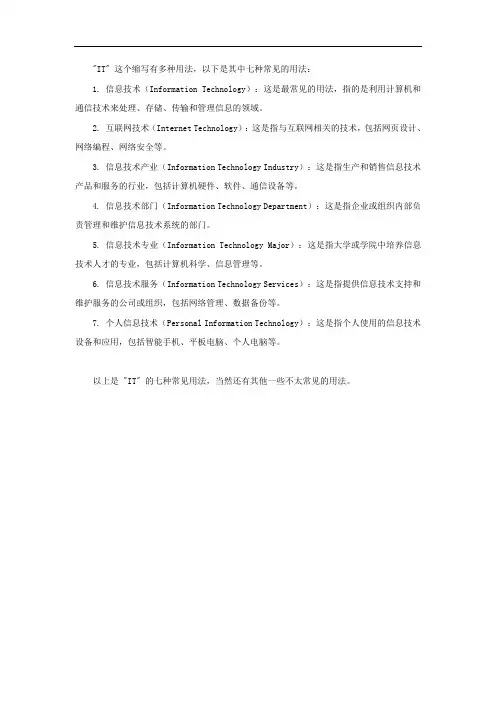
"IT" 这个缩写有多种用法,以下是其中七种常见的用法:
1. 信息技术(Information Technology):这是最常见的用法,指的是利用计算机和通信技术来处理、存储、传输和管理信息的领域。
2. 互联网技术(Internet Technology):这是指与互联网相关的技术,包括网页设计、网络编程、网络安全等。
3. 信息技术产业(Information Technology Industry):这是指生产和销售信息技术产品和服务的行业,包括计算机硬件、软件、通信设备等。
4. 信息技术部门(Information Technology Department):这是指企业或组织内部负责管理和维护信息技术系统的部门。
5. 信息技术专业(Information Technology Major):这是指大学或学院中培养信息技术人才的专业,包括计算机科学、信息管理等。
6. 信息技术服务(Information Technology Services):这是指提供信息技术支持和维护服务的公司或组织,包括网络管理、数据备份等。
7. 个人信息技术(Personal Information Technology):这是指个人使用的信息技术设备和应用,包括智能手机、平板电脑、个人电脑等。
以上是 "IT" 的七种常见用法,当然还有其他一些不太常见的用法。

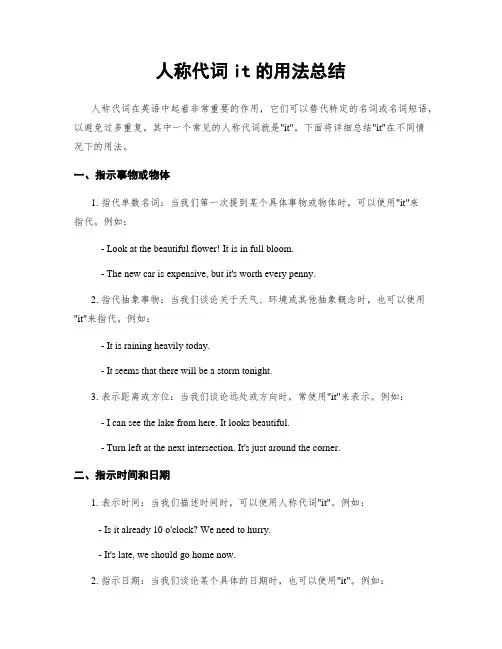
人称代词it的用法总结人称代词在英语中起着非常重要的作用,它们可以替代特定的名词或名词短语,以避免过多重复。
其中一个常见的人称代词就是"it"。
下面将详细总结"it"在不同情况下的用法。
一、指示事物或物体1. 指代单数名词:当我们第一次提到某个具体事物或物体时,可以使用"it"来指代。
例如:- Look at the beautiful flower! It is in full bloom.- The new car is expensive, but it's worth every penny.2. 指代抽象事物:当我们谈论关于天气、环境或其他抽象概念时,也可以使用"it"来指代。
例如:- It is raining heavily today.- It seems that there will be a storm tonight.3. 表示距离或方位:当我们谈论远处或方向时,常使用"it"来表示。
例如:- I can see the lake from here. It looks beautiful.- Turn left at the next intersection. It's just around the corner.二、指示时间和日期1. 表示时间:当我们描述时间时,可以使用人称代词"it"。
例如:- Is it already 10 o'clock? We need to hurry.- It's late, we should go home now.2. 指示日期:当我们谈论某个具体的日期时,也可以使用"it"。
例如:- I have an important meeting on Friday. It's going to be a long day.- The party is on Saturday night. It starts at 8 o'clock, so don't be late.三、指代动物和婴儿1. 指代动物:当我们不知道或不关心动物的性别时,可以使用"it"来指代动物。
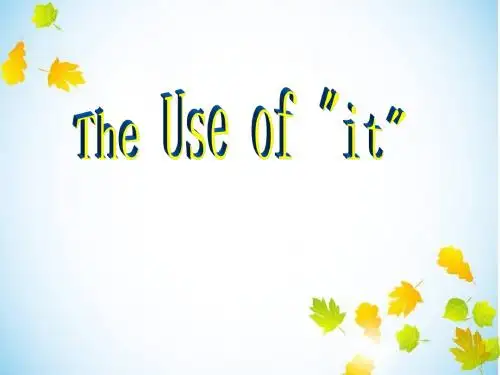
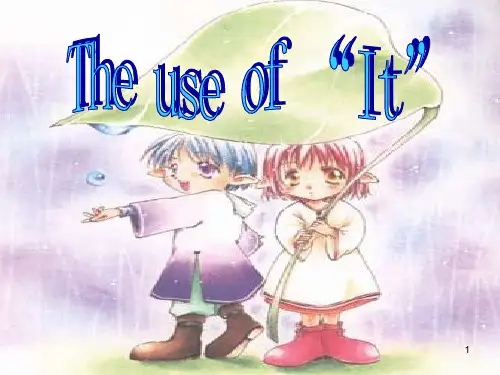
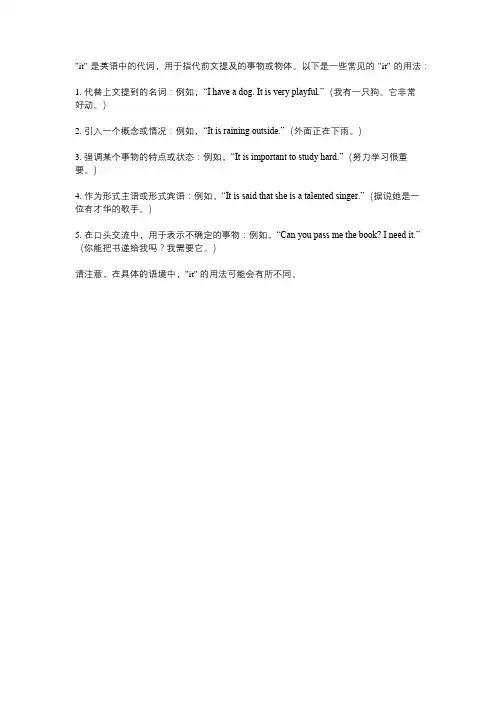
"it" 是英语中的代词,用于指代前文提及的事物或物体。
以下是一些常见的 "it" 的用法:
1. 代替上文提到的名词:例如,“I have a dog. It is very playful.”(我有一只狗。
它非常
好动。
)
2. 引入一个概念或情况:例如,“It is raining outside.”(外面正在下雨。
)
3. 强调某个事物的特点或状态:例如,“It is important to study hard.”(努力学习很重要。
)
4. 作为形式主语或形式宾语:例如,“It is said that she is a talented singer.”(据说她是一
位有才华的歌手。
)
5. 在口头交流中,用于表示不确定的事物:例如,“Can you pass me the book? I need it.”(你能把书递给我吗?我需要它。
)
请注意,在具体的语境中,"it" 的用法可能会有所不同。
it的用法it的用法:1、it作形式主语It is known to us that… 众所周知…… It is said that… 据说…… Itseems/appears that… 似乎/看起来…… It happened that… 碰巧……2、it作形式宾语 We consider it necessary to do sth. 我们认为有必要做某事 I find it difficult to answer the question. 我发现回答这个问题很难 He made it clear that… 他清楚地表明……3、it作形式定语 The book, which I bought yesterday, is interesting. 我昨天买的那本书很有趣The man who came just now is my teacher. 刚才来的那个人是我的老师4、it作宾语补足语 She looks pale, as if it were a disease. 她看起来苍白,好像生病了5、it作引导词It was not until then that … 直到那时才…… It is because of this that… 正因为如此才…… It is in this way that… 就是这样……6、it作状语It being Sunday, he didn’t go to work. 既然是星期日,他就不去上班了7、it作指代词 Everyone wants to have a good time, and it is true for me too. 每个人都想过的愉快的时光,对我来说也是一样。
8、it作副词 I worked harder than ever before, and it paid off. 我比以往更加努力,结果收获满满。
9、it作指示代词 Bring it here and put it on the table. 把它拿过来放在桌子上。
It 的用法在英语中,It有许多不同的用法,它既可以用作代词(如人称代词,非人称代词),也可以用做引导词(作形式主语或形式宾语),还可以用来构成强调句型等。
一、It 用做人称代词1.It 可用作人称代词,指前面已经提到的事物,动物或人,指人主要用于指性别不明的婴儿或用于确认某人的身份。
He bought a dictionary and gave it to me.The bady is crying. It might be hungry.Someone is ringing. Who might it be?Professor Lee gave us a lecture yesterday. It was of great interest.【说明】在答语中,常用来指本人,如说It's me。
二、It 用作指示代词1.在"It is/was+表语"结构中,it指明某人或某物的身份,如:①—Who is there downstairs? —It's the postman.②—Who is there talking? —It's your father.2.指代this 或that以及复合不定代词something, anything, nothing等。
①—What's that on the desk? —I guess it might be a robot.②This is your plan, isn't it? ③Nothing is wrong, is it?三、It 用作非人称代词It 用作非人称代词,常指代天气,季节,距离,时间或事物的状态。
It was raining when I left the office.It's February 14th today. It's a long time since we met last time.It's an hour's walk from my home to the school.It's so noisy in the room.四、It 用作形式主语当不定式、动名词、从句等复杂成分用作句子主语时,为保持句子平衡,通常把真正的主语放在句末,而在句首使用形式主语it。
it 在英语中的意思较多,用法较广,现总结如下;一、it作句子的真正主语1.it 指前面已经提到过的人或事物,有时指心目中的或成为问题的人或事物,作真正主语;例如:What’s this -It is a sheep这是什么这是一只绵羊;Who is it -It’s me I. 谁是我;It’s the wind shaking the window. 是风刮得窗户响;2.it指时间、季节;一般用在无人称动词的主语;例如:What time is it -It’s nine. 几点了九点了;It’s time for the meeting. Let’s go. 开会的时间到了,我们走吧;What day is today -It’s Saturday. 今天星期几今天星期六;What’s the date today -It is October 1st.今天是几号今天是十月一日;What season is it -It is summer. 现在是什么季节是夏季;3.it 指气候;一般作无人称动词的主语;例如:Is it cold in this room -No, it isn’t. 屋里冷吗不冷;What’s the weather like today -It is fine.今天天气怎么样是晴天;It often rains in summer and it often snows in winter in this city.这个城市夏天经常下雨,冬天经常下雪;4.it指距离、情况等;一般用作无人称动词的主语;例如:It is five kilometers from my home to the school.从我家到学校有五公里;It is very near from this factory to that one.从这个工厂到那个工厂非常近;It is a long way to the sea. 离海很远;Is it well with you 你身体好吗二、it作形式主语动词不定式、动名词短语起、从句在句子中起主语作用,而这一部分用词较多时,可以用it作为形式主语,放在句首代表其后所说的事实上的、真正的主语,而把真正的主语放在后面;1.It +谓语+动词不定式;It 作形式主语,动词不定式作真正的主语;例如:It is difficult to climb a mountain. 爬山是很艰难的;It’s a good habit to do morning exercises. 作早操是个好习惯;It’s important to do proper memory work in the study of a foreign language. 在学习外语时适当地做一些有助于记忆的练习是很重要的;It is right to do so. 这样做是对的;2.It+谓语+动名词短语;It 作形式主语,动名词短语作真正的主语;例如:It is dangerous playing with fire. 玩火是危险的;It is no use learning without thinking. 学而不思则罔;It’s useless arguing with a silly boy. 和笨孩子争论是没有用的;3.It +谓语+名词性从句;It 作形式主语,以that 引导的名词性从句是真正的主语;例如:It is a pity that you didn’t see such a good film.你没看这么好的电影,真可惜;It is certain that we shall succeed. 我们一定会成功;It is strange that nobody knows where he lives.真奇怪,谁也不知道他住在哪里;It is strange that…后面可用虚拟语气;如:It is strange that he should have made such a mistake.他居然犯了这样一个错误,真奇怪;It is strange that nobody should know where he lives.居然没有人知道他住在哪里,真奇怪;It is said that the plane will take off at ten tomorrow morning.据说飞机明天上午十点起飞;三、it作形式宾语it 作形式宾语,代表其后所说的真正的宾语;真正的宾语是以that 引导的名词性从句或不定式短语;例如:I consider it wrong that you Chinese students learn English without comparing it with your own language.我认为你们中国学生学习英语,不和你们自己的语言比较是不对的;I find it not so difficult to learn a foreign language.我发现学习一门外语不那么困难;I remember I made it clear to you that I was not coming.我记得向你明确表示过我不来;They want to make it clear to the public that they are doing an important and necessary job.他们要向公众表明,他们在做一件重要而又必要的工作;四、it 用于强调结构在表示强调的结构中,it 可用作先行代词,这种结构的句型如下:It +is/was +被强调的部分+that +其他部分;如果强调的部分是人,可用who, whom 代替that.例如:Professor Wang teaches us English every Monday afternoon.王教授每星期一下午教我们英语;强调主语:It is Professor Wang who teaches us English every Monday afternoon.强调间接宾语:It is us whom Prof. Wang teaches English every Monday afternoon. 强调直接宾语:It is English that Prof. Wang teaches us every Monday afternoon.强调状语:It is every Monday afternoon that Prof. Wang teaches us English.It was here that I first met him. 这就是我初次与他见面的地方;强调状语It is the people who are realy powerful.翻译练习1该上课了,快;It is time for class. Hurry up.2从这儿到你们学校远吗不远,大约一公里;Is it far from here to your school No, it isn’t. It’s about a kilometer.3从我家到颐和园去很近;It is very near from my home to the Summer Palace.4天正在下雨;It’s raining now.5电灯是爱迪生发明的;It was Edison who invented the electric light.6我认为学习一门外语是很重要的;I think it important to learn a foreign language.7他通常一天读两次英语;He made it a rule to read English twice a day.8从我家去天安门广场坐公共汽车大约要一个小时;It takes about an hour to go from my home to the Tian’anmen Square by bus.反意疑问句反意疑问句相当于“对不对”“好不好”“行不行”,用yes或 no 回答;由两部分组成,前一部分是陈述句,后一部分是附加疑问短语,中间用逗号隔开,所以反意疑问句又叫附加疑问句;通常的形式是:肯定的陈述句+否定的附加疑问,或否定的陈述句+肯定的附加疑问;如:He studies English, doesn’t heHe doesn’t study English, does heThey are from America, aren’t theyThey are not from America, are they反意疑问句的主要形式:1.如果主句是be或其他助动词如can, shall, will 等,其反意疑问句用同一助动词; 如:We are late, aren’t weYou haven’t met my wife, have youHe can drive a car, can’t heThey used to have difficulty in just making ends meet, didn’t usedn’t theyYou’d better eat with knives and forks, hadn’t you2.如果主语带有seldom, hardly, never, rarely, few, little等否定词或半否定词时,因为主句本身具有否定意义,附加疑问部分的动词用肯定式,如:We seldom go to the cinema, do weSue almost never worked, did she3.如果主句部分是“I am…”结构,由于”am not” 没有相应的缩略形式,附加疑问部分一般用aren’t I 代替;如:I am your friend, aren’t II’m late, aren’t II am a student, aren’t I在祈使句中的附加疑问部分一般用will you, won’t you.4. 在祈使句中的附加疑问部分一般用will you, won’t you.如:Sit down, will youHave some tea, won’t youOpen the window, won’t you这种句子可以理解为: Will you do something如:Will you open the window注意:否定的祈使句之后,只能用will.Don’t forget, will youDon’t make so much noise, will you5.以Let’s… 开头的祈使句,肯定的用shall we否定的用all right或OK,如:Let’s go back to our seats, shall weLet’s not have hot food this t ime, OK all right这种句子可以理解为:Shall we do something,如:Shall we go back to our seats.这样有助于理解和记忆;注意:Let’s 与Let us 的区别:Let’s包括听话人在内,应用shall we, 而Let us 不包括听话人在内,表示“请你让我们…”,要用will you.如:Let’s watch the news on TV, shall we 表示建议Let us watch the news on TV, will you 表示请求6.主句是I suppose, I think, I believe等时,附加疑问部分则往往与that 从句中的主语和谓语动词保持对应关系,但要注意否定的转移;如:I suppose that you know the meaning of the word, don’t you这句话明显是要问“你是不是知道”而不是问“我是不是这样认为”I don’t think that you have read the book, have you7.当主句的动词have 表示“拥有”时,附加疑问既可用have, 也可用do,如:You have a color TV set, haven’t you/don’t you当主句的have不表示“拥有”而表示其他意思时,附加疑问要用do,如:You had a cold yesterday, didn’t youThey don’t have coffee with breakfast, do theybe句型的反意疑问句,用there 作主语;如:There is something wrong, isn’t thereThere won’t be any trouble, will there 不会有任何麻烦,是吗9.陈述部分的主语是everyone, someone, anyone, no one, nobody等不定代词时,其疑问部分的主语可用he, 也可用they.Everyone knows it, doesn’t he/don’t they英语反意疑问句的回答有点和汉语的相反;但一定要记住:只要回答是肯定的,都用yes,只要回答是否定的,都用no;这在主句是否定句的时候要特别注意;例如:Mr. Jones can’t speak French, can he No, he can’t.琼斯先生不会讲法语,对吗对,他不会讲法语;Mr. Jones can’t speak French, can he Yes, he can.琼斯先生不会讲法语,对吗不,他会讲法语;This is not a door, is it -Yes, it is. It is an iron door.这不是门,对吗不,这是门;是扇铁门;。